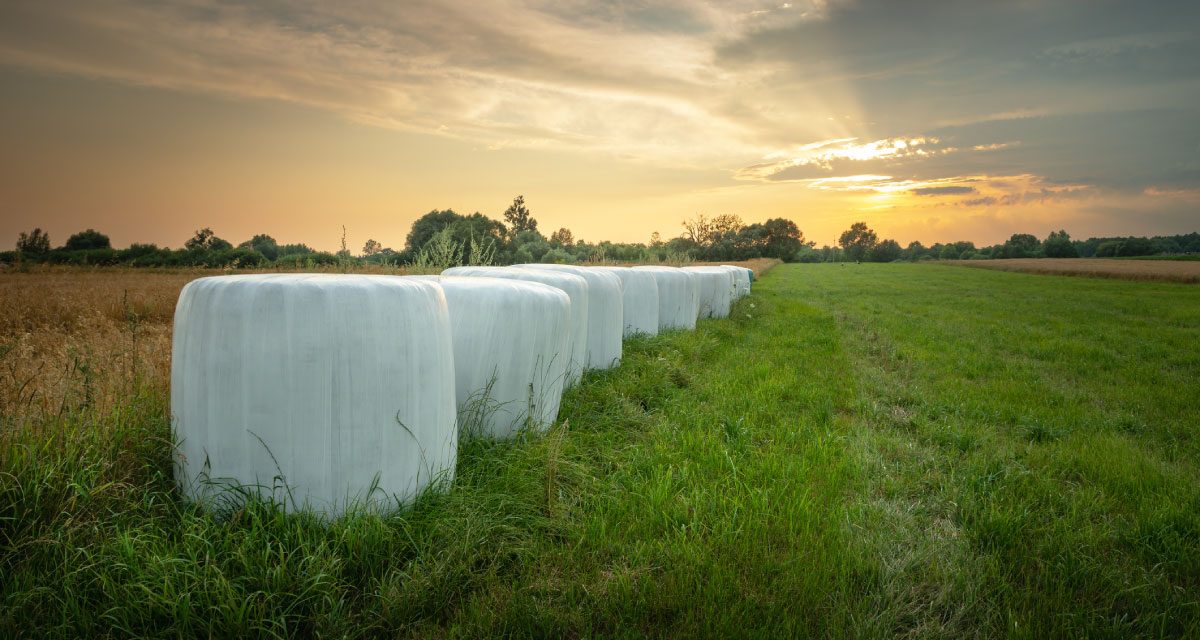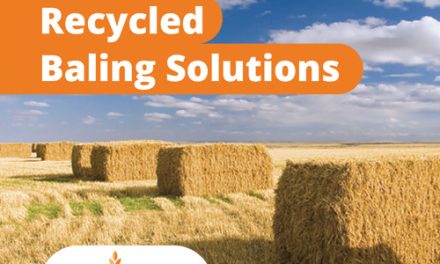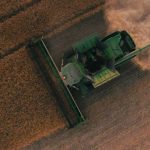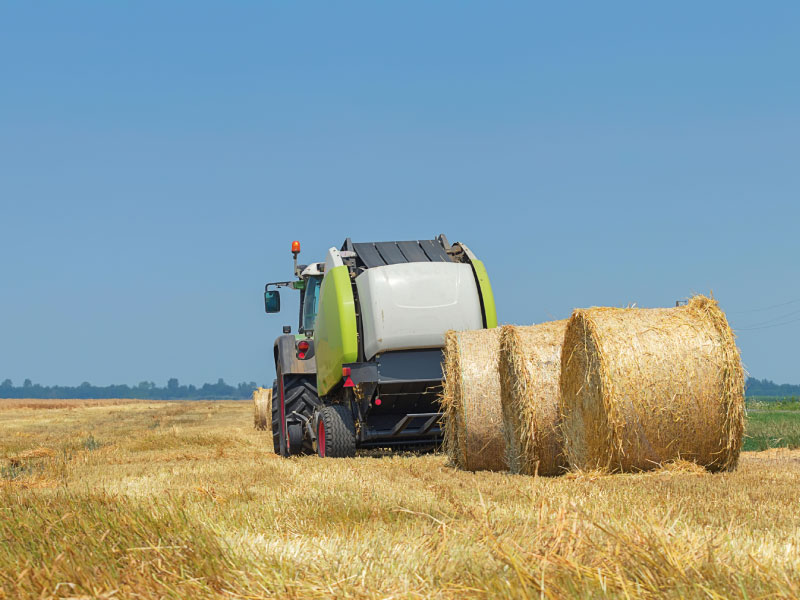
Bale wrapping: tips for successful silage bale wrapping

Bale wrapping is key to preserving forage in agriculture, ensuring its quality and durability. Proper bale wrapping protects silage from outside elements, guaranteeing its quality during storage and transportation.
In this article, we’ll share with you tips to choose and use bale wrap film. We’ll address all the essential aspects of successful wrapping from choosing the right size, verifying the materials used, and solving the most common problems to effectively place or use the wrap.
If you need any advice on the best wrapping for your silage, please do not hesitate to contact our team.
What is bale wrapping?
Bale wrapping is a technique that many farmers use to better preserve their forage. Wrapping bales correctly is an effective way to keep forage fresh and nutritious longer for feeding animals.
Basically, what is done is to wrap the hay or silage bales with an agriculture plastic film. This film protects the forage from air and moisture, which prevents it from rotting or spoiling.
By keeping oxygen out, you also prevent the growth of mold and harmful bacteria. If you want to know more about this topic you can read our article on how to prevent white mold in silage bales.
As we mentioned earlier, bale wrapping also helps maintain the nutritional value of the forage. When grass or hay is left out in the open, it can lose a lot of nutrients due to exposure to the sun and rain. But with the right bale wrap, those nutrients are better preserved.
Another advantage is convenience. Wrapping silage bales makes them easier to transport and store. You can stack them without worrying so much about the weather, and they occupy less space than if you leave them loose.
So… Why are silage bales wrapped in plastic?
While there are several reasons for wrapping silage bales, we will review the five main reasons below:
-
Protection against external elements
The wrapping provides an effective barrier against several external elements that could degrade forage quality.
-
Resistance to rain and humidity
The plastic acts as a waterproof shield, preventing rain and moisture from penetrating the bale, thus reducing the risk of spoilage due to excessive moisture.
-
Defense against pests and rodents
By being wrapped, hay bales become less accessible to pests such as insects and rodents, which could spoil the forage if not properly protected.
-
Preservation of forage quality
In addition to physical protection, the plastic helps maintain forage nutritional quality and reduce losses during storage and transportation. In this sense, it is also essential to consider the importance of the density of the bale to improve livestock nutrition.
-
Reduction of losses
Through the barrier provided by the plastic, losses due to fermentation and oxidation are minimized, allowing a better preservation of the forage and avoiding unnecessary waste.
Why are silage bales wrapped in different colors?
The function of film colors
When looking at wrapped silage bales, it is common to notice that some of them have different colors of the film. These colors are not just a matter of preference but also serve specific functions in the preservation of the forage.
- Crop differentiation: Using different colors of wraps allows farmers to distinguish the different crops in storage. This visual differentiation facilitates the organization and management of bales in storage.
- Quality indicators: In addition to differentiation, wrap colors can serve as quality indicators. For example, a specific color could be related to a type of forage or a specific preservation process, providing quick information on the quality of the contents.
- Environment: The black film contains a carbon black masterbatch, which is completely organic and naturally stable against UV radiation. Additionally, it is much more opaque, counteracting the greenhouse effect by better blocking IR radiation.
- Heat absorption: In contrast, lighter colors tend to reflect sunlight to a greater extent, which helps reduce heat absorption, maintaining a balanced temperature inside the bale. This characteristic can be beneficial in regions with hot climates, preventing overheating, and loss of forage quality.
If you want to know more about this topic we invite you to read our article on the advantages of black stretch film compared to white or green.
Choosing a wrapping film
As we already mentioned, choosing the right type of wrapping film is crucial to ensure the protection and preservation of stored forage.
The factors to be considered and the different types of films available are the following:
Factors to be considered
There are several factors to be considered:
- Type of crop: Each crop may require a specific type of wrapping film for optimum protection.
- Bale size: Bale size influences the choice of wrap thickness and resistance.
- Type of wrapping machine: The new generation machine, for example, is more speedy and more demanding. It is crucial to find the film that adapts to the machine requirements.
- Local weather conditions: Local weather must be considered to choose a wrapping film that will withstand adverse conditions.
Another aspect to consider, depending on the case, is the choice of baler twine.
Types of bale wrapping
- Wrapping film: agricultural film is a popular choice for protecting bales against moisture and UV rays, providing an effective barrier against outdoor elements.
- Net wrap: The net wrap provides adequate ventilation for the forage, preventing moisture accumulation and ensuring optimum crop quality preservation.
- NRF film (Net Replacement Film): the definition says it himself. A polyethylene film as an alternative to net wrap, easier to recycled and with superior oxygen barrier.
It’s worth mentioning the importance of reviewing the user’s manual of the baler machine used to determine the recommended wrap specifications. This step ensures a wise choice and proper application of the protective material.
Bale wrapping application
The most important aspects to consider for the proper application of bale wrapping are the following:
Recommended number of layers
- Methodology and process: It is essential to follow a proper methodology when applying bale wrapping to ensure uniform and complete coverage.
- Wrapping layers: The recommendation is to apply six layers of wrapping to ensure effective protection of the forage against external elements.
Plastic tension and adhesion
- Avoid oxygen penetration: Maintaining adequate tension in the plastic is essential to avoid oxygen penetration into the bale, which could affect its quality.
Ideal conditions for wrapping
- Avoid high temperatures: Avoid wrapping bales in high-temperature conditions, as this could compromise the effectiveness of the wrap and the preservation of the forage.
- Avoid rain: It is important to perform the wrapping process in dry weather conditions to ensure the tightness of the wrap and prevent moisture damage.
Other aspects to consider:
- The size of the bales must be constant.
- Always wrap the bales within two hours after bailing.
- Make sure the sticky side of the film reaches the bale.
- Always wrap good quality grass, cut at the optimum growth stage, ideally with 40-50% dry matter.
- If possible, wrap the bales near the storage, but if you wrap them in the field, move the bales to be stacked immediately after wrapping.
- Use a hydraulic type grab to handle bales. This applies to wrapped and unwrapped bales. Using a tine would leave a hole in the bale and allow oxygen to enter.
- When wrapping in warm weather, keep the roll in a box and locate it in a shaded area until you need it. This will prevent an excess of stickiness coming off the plastic. A film that is too sticky will cause adhesiveness to build up on the rollers of the stretching unit, inducing and “strangulation” of the film.
Storage considerations
The following are the key considerations for proper and efficient storage:
Efficient storage techniques
Once the bales have been transported to the storage site, their proper placement and storage are essential to maintain their quality. The recommended techniques are discussed below:
Bale stacking
Proper stacking of bales facilitates their preservation over time. Some of the recommended guidelines for effective stacking are as follows:
- Create compact and uniform vertical stacking to avoid collapses.
- Leave empty spaces between stacks to allow proper ventilation and prevent moisture accumulation.
- When stacking the bales, place them on their flat ends, where there is more plastic to protect them from uneven ground and bird damage.
Additional protection during storage
In addition to proper stacking, it is important to implement additional measures to protect the bales during prolonged storage. Some recommendations include:
- Use the polyethylene net over the top of the stack to cover and protect the bales from animals such as birds and cats.
- Locate the bales in an elevated and drained area to prevent possible flooding.
Practical tips for successful bale wrapping
The silage process, especially when focused on encapsulating hay and forage in protective bale netting, requires a strategic and informed approach to ensure optimal results are obtained.
Let’s look at three aspects that should also be considered for successful bale wrapping:
Machinery inspection
It is crucial to perform a thorough inspection of the machinery used in the bale wrapping process before each use. This practice allows the identification of possible failures and ensures the correct operation of the baler.
Inspect especially the cutting devices and pre-stretching unit which must be horizontally aligned at the same height as the centre of the bale.
Regular maintenance
Ensure that the wrapper and its pre-stretching unit are properly maintained.
This includes regularly cleaning the pre-stretch rollers with white spirit to remove any tack, especially for wrappers equipped with rubber rollers. Additionally, ensure that the pre-stretcher’s moving parts are adequately lubricated according to the manufacturer’s recommendations.
Staff training and education
Bale wrapping staff must be properly trained to operate the machinery safely and efficiently. Training helps improve productivity and reduces the risk of workplace accidents.
Frequently asked questions on bale wrapping
What is the best machine for bale wrapping?
Choosing the right machine to wrap bales depends on several factors. Round balers are ideal for fast and efficient wrapping, while combined balers and wrappers offer versatility in the process.
Round bale wrappers are optimal for transportation and stacking, while square bale wrappers are ideal for the silage made of diverse materials.
For square bales, should any special agricultural stretch film be applied?
To make high density bales, would you suggest a fixed or a variable chamber baler?
What can be the cause of the white mold on silage bales and how to prevent it?
We invite you to watch the full webinar related to the agricultural stretch films.
Conclusion
As we have seen, proper wrapping of silage is essential to preserve and protect silage bales. The integrity and specific characteristics of the materials used for this purpose will have a direct impact on the performance of the wrapped bales and, ultimately, on the quality of the ensiled forage.
Looking for bale wrappers made of durable, high-quality materials that are well suited to the rigors or severities of silage and making sure to ask about and evaluate important factors such as puncture resistance, UV protection, and overall tensile resistance is critical.
Prioritizing robust and reliable wrapping is an essential aspect of risk management, as it ensures that the silage remains safely protected from initial baling to the time of use.
By following the tips and recommendations we have reviewed above, you can ensure the success of silage bale wrapping.
Other articles of interest:
- Maximizing silage yields with microbial inoculants
- What are the advantages of black agricultural stretch film compared to white or green?
Sources:
- EyouAgro. (January 9, 2022). 5 Tips To Use The Right Bale Wrap For Your Silage Saving. Retrieved from: https://eyouagro.com/blog/5-tips-to-use-the-right-bale-wrap/
- LinkedIn.com. (April 30, 2020). Bale Wrapping Tips. Retrieved from: https://www.linkedin.com/pulse/bale-wrapping-tips-robert-welburn/
- Midwestforage.org. (May 2016). Tips for Successful Bale Wrapping & Quality Baleage. Retrieved from: https://www.midwestforage.org/pdf/1024.pdf.pdf
- Sigma Stretch Film. (no date). Balewrap 101. Retrieved from: https://www.sigmastretchtools.com/bale-wrap-guide
- Tama Australia. (August 4, 2019). Strechfilm – The Ten Top Tips of Bale Wrapping. Retrieved from: https://www.tama-australia.com.au/strechfilm-the-ten-top-tips-of-bale-wrapping/





![[eBook] Sustainability and water management](https://agriplasticscommunity.com/wp-content/uploads/8_550x310_ENG-440x264.png)
![[eBook Trends in Agriculture Plastics] Increasing use of biodegradable mulch](https://agriplasticscommunity.com/wp-content/uploads/550 × 310_2_ENG-440x264.png)
![[eBook Trends in Agriculture Plastics] Reducing the plastic used in the manufacture of agricultural films](https://agriplasticscommunity.com/wp-content/uploads/550 × 310_1_ENG-150x150.png)














![[eBook Trends in Agriculture Plastics] Cultivation of fruit trees under cover](https://agriplasticscommunity.com/wp-content/uploads/4_550x310_ENG-440x264.png)






